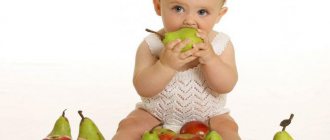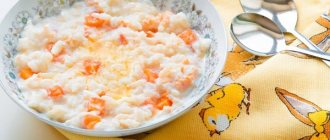Children who feed on breast milk for six months sooner or later become interested in food from the adult table. This is a signal that it is time to introduce complementary foods. Young mothers wonder where to start and how? To select the first product for a baby, his individual developmental characteristics, age, stool condition and the baby’s readiness for a new diet are taken into account.
Boy with a blue spoon
Complementary feeding calendar table
| 4 months | 5 months | 6 months | 7 months | 8 months | 9-12 months | |
| Vegetable puree | 10 -120 ml | 150 ml | 150 ml | 170 ml | 180 ml | 200 ml |
| Porridge | 10-120 ml | 150 ml | 150 ml | 170 ml | 180 ml | 200 ml |
| Fruit puree | — | 5-60 ml | 60 ml | 70 ml | 80 ml | 90-100 ml |
| Meat puree | — | — | 5-30 ml | 30-50ml | 50-60 ml | 70-80 ml |
| Juices | — | — | 5-60 ml | 70 ml | 80 ml | 90-100ml |
| Cottage cheese | — | — | — | 10-40 g | 40 g | 50 g |
| Yolk | — | — | — | 0,25 | 0,5 | 0,5 |
| Cookies, crackers | — | — | — | 5 g | 10 g | 10 g |
| Fish | — | — | — | — | 5-30 g | 30-60 g |
| Kefir | — | — | — | — | 10-150 g | 200 g |
| Bread | — | — | — | — | 5 g | 10 g |
| Vegetable oil | 3 g | 5 g | 5 g | 10 g | 10 g | 10 g |
| Butter | 3 g | 5 g | 5 g | 10 g | 10 g | 10 g |
Buckwheat porridge for first feeding
Buckwheat is ideal for a child's first complementary feeding, as it is safe and does not cause allergies, and has a positive effect on digestion. Buckwheat strengthens and supports the body, improves immunity, and has a beneficial effect on the condition of the skin, hair and teeth. This product is quickly digested and well absorbed. It does not contain gluten and contains a lot of useful elements, vitamins and minerals. Now let’s find out how to cook buckwheat porridge for babies.
For the first test, the dish is cooked in the proportion of 5 grams of cereal per 100 ml of water, which is half a standard glass of water and a teaspoon of cereal. Buckwheat should be of the highest quality and not too dark. Sort through the grains, remove those that are too dark and black, rinse thoroughly in cool water, and let dry.
Prepared dried buckwheat is passed through a coffee grinder or blender. The grains are poured with water and cooked over low heat for 15 minutes. Add diluted formula or breast milk in an amount of 20-30 ml to the finished dish; after seven months, you can give the baby two or three drops of vegetable oil, and at eight months of age, children are given butter along with buckwheat.
After eight months, vegetables and fruits begin to be added to the porridge. Carrots, pumpkin and zucchini work well. In the ninth month, chopped meat is already added to the recipe, and a little later, fish. The ingredients are stewed in vegetable oil or boiled separately, but under no circumstances should they be fried! The components must be prepared separately, then chopped and only then added to the porridge. You will find various buckwheat recipes for babies here.
Despite the benefits of buckwheat, if you overeat it can also cause harm. When in excess, this cereal causes stomach upset, stool disturbances, and bloating. To avoid this, you need to thoroughly wash and prepare the grains, store the product in a dry, dark and cool place, and follow the rules of preparation and feeding. Don't give your baby too much food, stick to the recommended amounts!
Risks associated with the introduction of complementary foods
Risk of infectious diseases
The introduction of complementary foods increases the risk of infectious diseases. This risk is especially high in underdeveloped countries. It is this risk that is associated with the WHO recommendation not to give a child under 6 months anything other than breast milk. For developed countries, this risk is not relevant. The introduction of complementary foods does not significantly affect the frequency of intestinal infections in children of the first year of life.
Introducing complementary foods increases the risk of food allergies
- Each new food product can cause an allergy in a child, but there is a critical window for the formation of food tolerance when the risk of developing a food allergy is lowest. This is the age of the child from 4 to 6 months.
- At this time, the child’s intestinal microflora is formed with a predominance of bifidobacteria.
- The kidneys and gastrointestinal tract are functionally ready for the introduction of complementary foods.
- The initially increased permeability of the intestinal wall in children decreases.
Up to 4 months - the intestinal wall is permeable, there are few enzymes, the microflora is not formed - early introduction of complementary foods (up to 4 months) increases the risk of food allergies .
It would seem that later introduction of complementary foods can save you from food allergies. It turns out that this is not the case. With the late introduction of complementary foods (after 6 months), there is a need to quickly introduce a large number of new products. A large antigenic and digestive load on the body can cause the development of food allergies. At 4-6 months, the child’s level of maternal immunoglobulins in the blood decreases, and his own, including allergic immunoglobulins, have not yet begun to be actively produced; the older the child, the more actively they begin to be produced, so introducing complementary foods at a later date can give a start development of food allergies.
Risk of gaining excess body weight
The introduction of complementary foods can lead to excess body weight. But only with the early introduction of complementary foods, before 4 months. Early introduction of complementary foods increases the risk of obesity in the future.
Risk of developing iron deficiency anemia
The timing of the introduction of complementary foods affects the risk of developing a deficiency of microelements and vitamins, especially iron. Approximately 1/3 of women suffer from anemia by the end of pregnancy. The later the introduction of complementary foods, the higher the risk of iron deficiency in the child.
If complementary foods are introduced from 4 months, the level of serum ferritin in the child’s blood is higher than when complementary foods are introduced later (from 6 months and later). When complementary foods are introduced from 6 months and later, the risk of iron deficiency in the child increases .
How to properly introduce porridge into complementary foods
- For the first feeding, give buckwheat porridge to your baby in the amount of half a teaspoon. Then gradually increase the portion to 150 grams. The daily norm of any porridge for a child per year is 180-200 grams;
- Porridge for children under one year old is prepared without salt and sugar. For taste, vegetable or butter, breast milk or formula are added to the finished dish. Sugar and salt can be added after 12 months;
- When you try it for the first time, observe your baby’s reaction. If you observe signs of a food allergy, eliminate the product from your diet and contact your pediatrician;
- Milk porridge is turned on after each cereal is introduced, except semolina. Semolina is introduced last, as it is very allergenic and contains a large amount of gluten;
- Gluten cereals (semolina, oatmeal and barley) are included after gluten-free cereals. Gluten is a strong allergen that negatively affects digestion and irritates the mucous membranes of the baby; it takes a long time and is difficult to digest;
- The consistency of the first porridges resembles liquid puree. It must be free of lumps! Then the proportion of cereal is gradually increased and the dish is cooked thicker;
- After the product is introduced into complementary foods, fruits and vegetables, dried fruits, meat and fish purees can be used in the cooking recipe (after eight to nine months);
- It is advisable to prepare fresh porridge every time; in extreme cases, you can store food in the refrigerator for no more than a day. Heat food in a water bath, but not in the microwave or on the stove!;
- Give the dish to the baby warm. After cooking, wait until the porridge cools down to room temperature, as hot food will burn the baby's stomach. But there is no need to give your child cold food, as it loses most of the vitamins;
- If you don't want to cook porridge yourself, choose a ready-made product. It contains a balanced composition designed specifically for infants;
- Ready-made baby food is chosen carefully, checking the composition, expiration date and integrity of the packaging. It must be appropriate for the child's age. In addition, the product must not contain gluten, soy, rapeseed oil, palm oil, or sugar. It’s good if the composition includes vitamins and minerals, pro- and prebiotics, and beneficial acids.
Prohibited Products
Complementary foods for a breastfed or bottle-fed baby should not be supplemented with whole milk. The digestive system of a baby at 6 months is not yet perfect; it is difficult for the pancreas to digest this product. When milk is consumed, the minerals and salts it contains can accumulate in the baby's kidneys.
Fish, due to its allergenic component, is also best put off for up to a year. First of all, sea fish is introduced. With the introduction of river fish, there is no need to rush.
The following are prohibited:
- spicy, salty dishes, sauces, marinades;
- chocolate, sweets, honey, carbonated drinks;
- sausages, smoked products;
- nuts.
Failure to follow these recommendations may result in:
- development of allergies;
- disruption of the pancreas;
- intestinal disorder.
Recipes for preparing vegetable puree for first feeding
First food: vegetable puree. Just a few weeks ago, your baby only ate breast milk or formula from a bottle, but now he can confidently roll over and sit up, and some can boast of their first teeth. It's time to buy your baby's first high chair and offer him vegetable puree as complementary food. But not all mothers know how to cook it correctly, so we will share simple recipes.
You can read about how to cook meat for children under one year old HERE
From potatoes
Wash and dry the potatoes, peel them and rinse again. Cut into cubes and place in a saucepan, add water and let stand for a few minutes.
Now you need to drain the water, pour in clean water and cook over low heat until the root vegetable is ready. Skim off the foam if necessary and after cooking, drain the broth, grind the puree, rub it through a sieve and dilute it to the desired consistency with broth, breast milk or a mixture. For older kids, you can salt the puree with a grain of salt and add butter.
From zucchini
Wash the zucchini thoroughly in running water, dry and peel off the skin, seeds and fibers that hold the seeds. That is, essentially only pure pulp of the fruit remains.
It needs to be cut into small pieces, add water and boil over low heat for about 15 minutes. Drain the water, press the zucchini into the pan with a spoon and squeeze out excess moisture.
Grind with the addition of breast milk or hot mixture, grinding with a blender or mixer knives. It will not be possible to strain this vegetable through a sieve - it is too fibrous for this purpose. All that remains is to cool to the desired temperature and start feeding the baby.
When to introduce nuts into your child’s diet: read our article HERE
From broccoli
Before cooking, the cabbage should be disassembled into florets and soaked in cool, salted water to wash away dirt and possible insects.
After 1-1.5 hours, drain the water, rinse the cabbage well again and add clean water to cook. But you shouldn’t overcook the broccoli; 15-18 minutes over low heat will be enough.
Pour the broth into a clean container; you may need it to bring the puree to a smooth consistency if you do not want to dilute the vegetable with breast milk or formula.
Grind the cabbage in a blender until pureed, add liquid and puree the mixture again. If necessary, you can rub the puree through a fine sieve, cool and you can feed the baby.
From pumpkin
Peel a piece of pumpkin from the peel and seeds, carefully clean the area of the seeds from the fibrous part and cut into cubes.
Pour in cold water, boil until tender, drain the broth, add milk and heat. Now you need to wipe the vegetable or chop it with a mixer, add liquid if necessary and rub it through a sieve. Otherwise, the finished product may contain fibrous lumps that the baby can choke on.
Heat the finished puree to a temperature of 37C and feed the child the amount prescribed according to the scheme.
ADVICE! A frozen product is perfect for making pumpkin puree; you just don’t need to defrost the vegetable cubes - just rinse them with water and let them cook.
From cauliflower
Disassemble the head of cabbage into inflorescences, add water and leave for 1 hour. To get rid of dirt and parasites in the inflorescences that may get there, the water can be salted.
Rinse the vegetable in running water and add a small amount to simmer. After boiling, remove the foam, boil for 15 minutes and drain the broth.
Grind the inflorescences in a blender with the addition of broth or milk, rub through a sieve and, after cooling, offer to the baby as lunch.
Is it possible to have fruit juices, meat, eggs
Modern pediatricians are against the early introduction of juices. They believe that in this case there is a high risk of developing undesirable consequences for the digestive organs: pancreas, stomach and intestines.
Only when vegetables, fruits and cereals have been introduced can juices diluted with water in a 1:1 ratio be introduced.
Egg yolk is rich in lecithin, B vitamins, folic acid, vitamin D and zinc. However, pediatricians recommend introducing it no earlier than 8-9 months, when the baby has already been introduced to first-choice foods.
For a baby on artificial nutrition, shifts to an earlier time are possible. It's better to start with the yolk of quail eggs. They are easier to digest. In this case, complementary foods begin to be introduced with half the yolk.
Meat is necessary for the growth and strengthening of the child’s immunity. It is rich in valuable amino acids, zinc, vitamin D and iron. But meat is a difficult product for digestion. Therefore, if you started feeding a child at six months, meat is introduced no earlier than 7-8 months. If the baby has anemia, then it is allowed not to withstand this period.
Preference is given to lean, dietary meats: chicken, beef, turkey and rabbit. You need to start with a portion equal to 0.5 tsp, combining meat puree with vegetables and cereals.
Complementary feeding at 6 months with artificial feeding can be expanded with meat, homogenized (canned) purees after consultation with a doctor, if the child has a lack of iron depot. Homemade purees made from meat are best left for up to 8-9 months.
General rules
Complementary feeding at 6 months with artificial feeding can be introduced 2-4 weeks earlier than for a baby who is fed breast milk, since no formula can compare with it in composition. You need to introduce unfamiliar foods carefully and slowly. Otherwise, the digestive system may malfunction.
The signal to start expanding the menu is the baby’s food interest in food. The question of which product to start complementary feeding should be discussed with your pediatrician. If the child is gaining little, then it makes sense to introduce porridge first. For a well-fed baby prone to constipation, it is better to offer vegetable puree.
At the moment, two concepts of product introduction can be distinguished: pediatric and pedagogical.
In the case of the first type of complementary feeding, the expansion of the menu occurs gradually, according to a certain pattern. With a pedagogical view on the issue of complementary feeding, the child tries pieces from the mother’s plate, gradually becoming familiar with the food that is eaten in the family. Each method has advantages and disadvantages.
Pediatric complementary foods
Goal: transfer from mother's milk/special formula to food accepted in the family. Complementary foods are introduced according to the following scheme: they begin to offer the product in a small dosage, and within 5-7 days the portion is increased to full. Food is prepared separately.
Pros:
- Meals according to the schedule.
- A food diary will be introduced.
- A clear scheme, regime.
- It is possible to track which product you were allergic to.
Minuses:
- The mother has to cook for the child separately.
- The child does not learn table manners. Loss of appetite.
- Complementary foods are served in the form of a puree, which does not contribute to the ability to swallow and chew.
Pedagogical complementary feeding
Goal: accustoming the family to eating behavior. The child begins to eat with his mother from the same plate. Food for the child is not prepared separately. The child receives food in the form of microdoses.
Pros:
- With this method, the child begins to produce enzymes that help digest food.
- Complementary feeding does not replace mother's milk.
- The child quickly learns table manners.
- There is no need to cook separately for the baby.
- The child has no problems with appetite and chewing skills.
- Breastfeeding remains primary.
Minuses:
- At the very beginning of complementary feeding, the child may choke on small pieces.
- It is difficult to trace what caused this or that negative reaction.
Recommendations
You can start complementary feeding if your child:
- increased its weight 2 times after birth (for a premature baby 2.5 times);
- is interested in food and watches how older family members eat;
- able to eat from a spoon without reflexively pushing the food out with the tongue;
- sits confidently;
- the main supply ceases to be enough.
If most of these signs are present, then after consultation with a pediatrician, in the absence of contraindications , you can begin introducing new products, following certain rules:
- You should not give unfamiliar foods when you feel unwell;
- only one new product is offered per day;
- unfamiliar foods are given from a spoon before lunch, preferably during the second feeding;
- food should have a comfortable temperature;
- It is better to be the first to offer one-component vegetable purees, starting from 5-10 g, gradually increase the serving size to 100 g;
- each subsequent new product is introduced after the child has mastered the previous one;
- You can add mother’s milk/special formula to porridges prepared with water;
- first, the baby is given 10 grams of porridge, over 5-7 days the volume is increased to 150 grams;
- when the child begins to eat cereals and vegetables, fruits are introduced, starting with 5 grams of one-component puree, every day, increasing the portion size to a daily dose of 30 grams;
- multi-ingredient soups and stews can be offered to a child only after he has tried all the ingredients separately, in order to avoid possible negative reactions.









